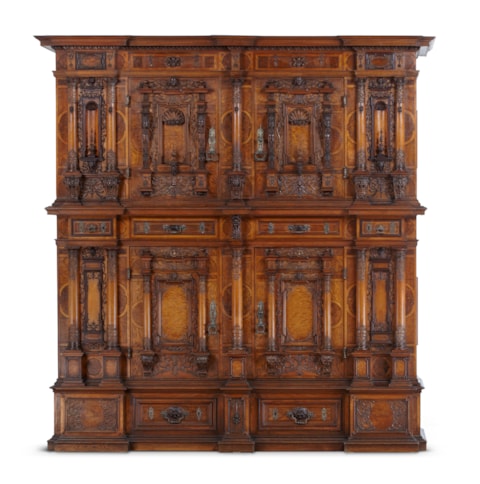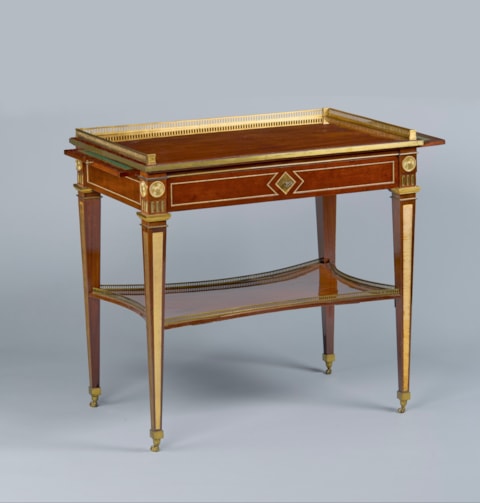
A Russian mahogany and ormolu-mounted mechanical Bureau ‘Bonheur du Jour’
Heinrich Gambs (Wurttemberg 1765 – 1831 St. Petersburg)
St. Petersburg, c. 1800
mahogany and ebony, ormolu mounts
On the underside, black ink inventory number ‘No=86’ and ‘Salle 56’ (probably for Pavlovsk Palace in St. Petersburg).
134 x 90,5 x 58,5 cm
The top with white marble panel with a pointed arch and leaf decoration in the centre, urns at the corners above a frieze with laurel leaves andlozenge mounts and two tambour doors that open to reveal shelves above small drawers, flanked by gilt female hermae pilasters.
The central pilaster panel with an Apollo mask can be opened by a secret mechanism to reveal hidden drawers.
The desk element below is decorated with a frieze drawer with a relief in gilded bronze on an ebony ground. The keyhole is decorated with hieroglyphics and flanked by opposing sphinxes and arabesques with eagles. Side lion's head fittings on ribbed diamond-shaped plates allow the writing surface with integrated side drawers with concealed spring mechanisms to be opened on faceted octagonal legs (with steel screw threads typical of the Roentgen workshop) with gilded floral capitals under mille-raies bronzes, connected to a concave shelf with gallery.
The shape of our filigree desk with its sophisticated mechanism is probably based on a design by the famous architect Andrei Voronikhin (1759-1840), with whom H. Gambs frequently collaborated, particularly on the interior design of Pavlovsk, the Russian Tsar's palace, which was refurbished after the great fire of 1803.
Prov.: Pelham Galleries, London; Grosvenor House Arts & Antiques Fair, London, 1986; Coll. E. and J. D. Wolfensohn, New York.
The central pilaster panel with an Apollo mask can be opened by a secret mechanism to reveal hidden drawers.
The desk element below is decorated with a frieze drawer with a relief in gilded bronze on an ebony ground. The keyhole is decorated with hieroglyphics and flanked by opposing sphinxes and arabesques with eagles. Side lion's head fittings on ribbed diamond-shaped plates allow the writing surface with integrated side drawers with concealed spring mechanisms to be opened on faceted octagonal legs (with steel screw threads typical of the Roentgen workshop) with gilded floral capitals under mille-raies bronzes, connected to a concave shelf with gallery.
The shape of our filigree desk with its sophisticated mechanism is probably based on a design by the famous architect Andrei Voronikhin (1759-1840), with whom H. Gambs frequently collaborated, particularly on the interior design of Pavlovsk, the Russian Tsar's palace, which was refurbished after the great fire of 1803.
Prov.: Pelham Galleries, London; Grosvenor House Arts & Antiques Fair, London, 1986; Coll. E. and J. D. Wolfensohn, New York.




